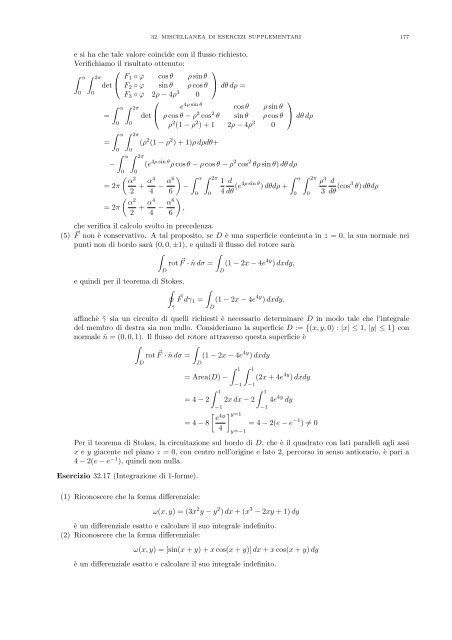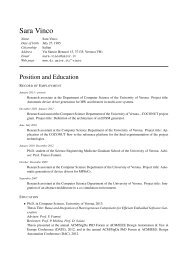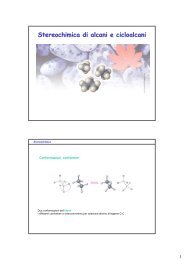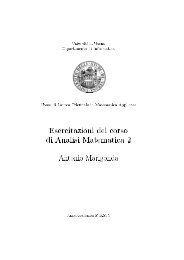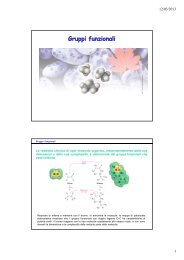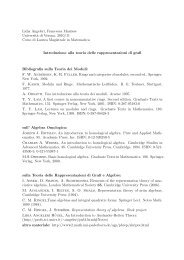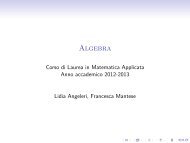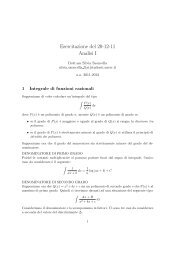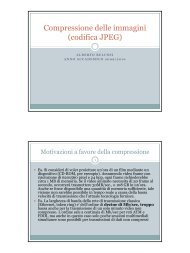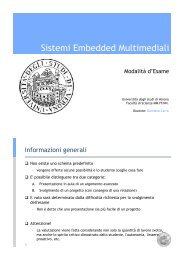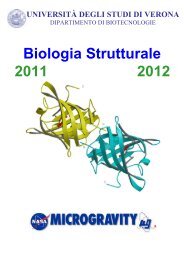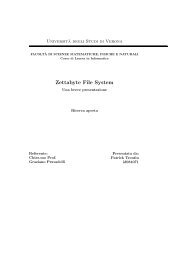Create successful ePaper yourself
Turn your PDF publications into a flip-book with our unique Google optimized e-Paper software.
32. MISCELLANEA DI ESERCIZI SUPPLEMENTARI 177<br />
e si ha che tale valore coincide con il flusso richiesto.<br />
Verifichiamo il risultato ottenuto:<br />
⎛<br />
α 2π<br />
det ⎝<br />
0 0<br />
F1 ◦ ϕ cos θ ρ sin θ<br />
F2 ◦ ϕ sin θ ρ cos θ<br />
F3 ◦ ϕ 2ρ − 4ρ3 ⎞<br />
⎠ dθ dρ =<br />
0<br />
⎛<br />
α 2π<br />
e<br />
= det ⎝<br />
0 0<br />
4ρ sin θ cos θ<br />
ρ cos θ − ρ<br />
ρ sin θ<br />
2 cos2 θ sin θ ρ cos θ<br />
ρ2 (1 − ρ2 ) + 1 2ρ − 4ρ3 ⎞<br />
⎠ dθ dρ<br />
0<br />
=<br />
α 2π<br />
−<br />
0 0<br />
α 2π<br />
0<br />
0<br />
2 α<br />
= 2π<br />
2<br />
2 α<br />
= 2π<br />
2<br />
(ρ 2 (1 − ρ 2 ) + 1)ρ dρdθ+<br />
(e 4ρ sin θ ρ cos θ − ρ cos θ − ρ 2 cos 2 θρ sin θ) dθ dρ<br />
+ α4<br />
4<br />
+ α4<br />
4<br />
<br />
α6<br />
− −<br />
6<br />
− α6<br />
6<br />
<br />
,<br />
α 2π<br />
0<br />
0<br />
1 d<br />
4 dθ (e4ρ sin θ ) dθdρ +<br />
α 2π<br />
0<br />
0<br />
ρ 3<br />
3<br />
d<br />
dθ (cos3 θ) dθdρ<br />
che verifica il calcolo svolto in precedenza.<br />
(5) F non è conservativo. A tal propos<strong>it</strong>o, se D è una superficie contenuta in z = 0, la sua normale nei<br />
punti non di bordo sarà (0, 0, ±1), e quindi il flusso del rotore sarà<br />
<br />
rot <br />
F · ˆn dσ = (1 − 2x − 4e 4y ) dxdy,<br />
e quindi per il teorema di Stokes,<br />
<br />
F dγ1 =<br />
D<br />
˜γ<br />
D<br />
D<br />
(1 − 2x − 4e 4y ) dxdy,<br />
affinchè ˜γ sia un circu<strong>it</strong>o di quelli richiesti è necessario determinare D in modo tale che l’integrale<br />
del membro di destra sia non nullo. Consideriamo la superficie D := {(x, y, 0) : |x| ≤ 1, |y| ≤ 1} con<br />
normale ˆn = (0, 0, 1). Il flusso del rotore attraverso questa superficie è<br />
<br />
rot <br />
F · ˆn dσ = (1 − 2x − 4e 4y ) dxdy<br />
D<br />
D<br />
= Area(D) −<br />
1<br />
= 4 − 2<br />
−1<br />
4y e<br />
= 4 − 8<br />
4<br />
1 1<br />
−1<br />
2x dx − 2<br />
y=1<br />
y=−1<br />
(2x + 4e 4y ) dxdy<br />
−1<br />
1<br />
−1<br />
4e 4y dy<br />
= 4 − 2(e − e −1 ) = 0<br />
Per il teorema di Stokes, la circu<strong>it</strong>azione sul bordo di D, che è il quadrato con lati paralleli agli assi<br />
x e y giacente nel piano z = 0, con centro nell’origine e lato 2, percorso in senso antiorario, è pari a<br />
4 − 2(e − e −1 ), quindi non nulla.<br />
Esercizio 32.17 (Integrazione di 1-forme).<br />
(1) Riconoscere che la forma differenziale:<br />
ω(x, y) = (3x 2 y − y 2 ) dx + (x 3 − 2xy + 1) dy<br />
è un differenziale esatto e calcolare il suo integrale indefin<strong>it</strong>o.<br />
(2) Riconoscere che la forma differenziale:<br />
ω(x, y) = [sin(x + y) + x cos(x + y)] dx + x cos(x + y) dy<br />
è un differenziale esatto e calcolare il suo integrale indefin<strong>it</strong>o.


